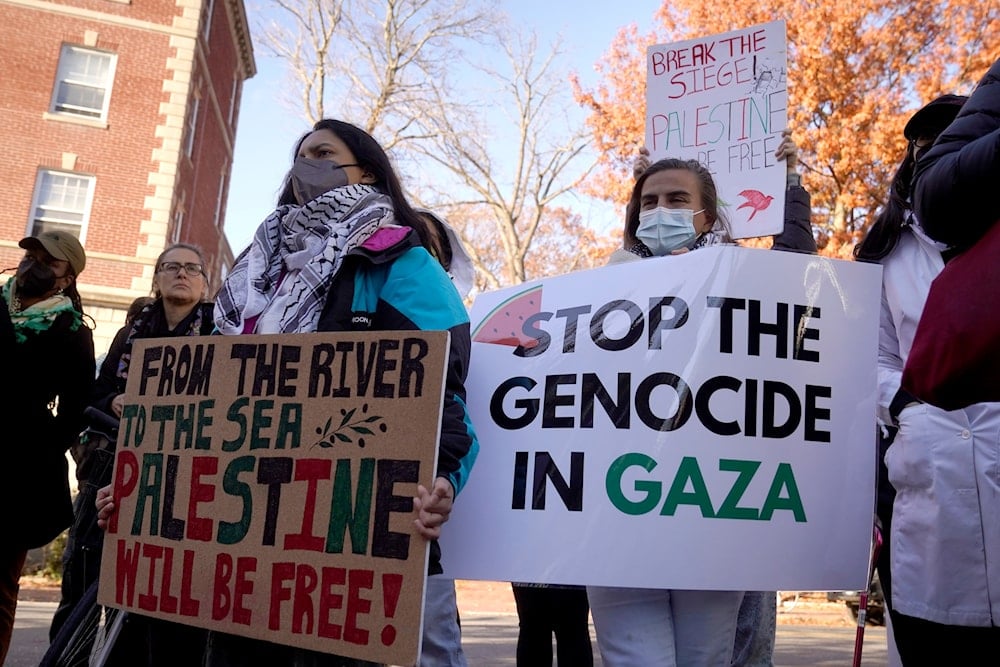Final ceasefire formula fulfilled Hamas demands: Al Mayadeen's sources
Hamas stipulates the release of Palestinian women and children in Israeli occupation prisons in exchange for the release of dozens of settlers held captives in Gaza.
-

Pro-Palestinian demonstrators display signs outside the home of US Sen. Elizabeth Warren, D-Mass., during a protest Sunday, Nov. 19, 2023, in Cambridge, Mass., held to call for a ceasefire in Gaza. (AP Photo/Steven Senne)
Al Mayadeen's sources revealed that the final formula for the ceasefire has fulfilled all the conditions set by Hamas, indicating that the Palestinian Resistance movement expressed its readiness to release the Israeli settlers held captives since the beginning of Operation Al-Aqsa Flood, pointing out that the Israelis are the ones delaying the implementation until now.
According to the sources, Hamas had stipulated the release of Palestinian women and children in Israeli occupation prisons in exchange for the release of dozens of settlers held captives in Gaza.
The sources indicated that in order to secure the release of these Israeli captives, Hamas requested a five-day ceasefire, with the provision of a secure environment and a halt to the movement of Israeli drones over the Gaza Strip.
The Resistance stipulated that aid enter both the southern and northern parts of the Gaza Strip rather than only the South, where humanitarian aid trucks were allowed to enter in the past weeks through the Rafah Crossing.
In a related context, Axios cited three informed sources that negotiations for the release of Israeli captives held in the Gaza Strip "are back on and showing modest progress after a pause lasting several days."
The sources mentioned that the head of Hamas in Gaza, Yahya Sinwar, had halted contact with the movement's representatives in Doha after the Israeli occupation forces stormed al-Shifa Hospital.
However, Sinwar resumed contact in the past 24 hours, sending a new response to Qatari mediators, indicating a narrowing of some gaps between the two parties, but not enough to reach an agreement, the sources revealed.
Axios cited two sources as saying that the specifics of the agreement are still being worked out, and there are daily alterations to its details.
"Sometimes there are changes every hour," one source was quoted as saying.
According to the sources, if reached, the agreement would be implemented in two stages: the first involves the release of about 50 women and children held by Hamas in exchange for a five-day ceasefire. As for the second stage, it includes locating more women and children captives held by other Palestinian Resistance factions to release them, with this process taking place during the five-day ceasefire.
Two of the sources told Axios that Sinwar has tentatively agreed to expand the number of women and children to be released under the two-stage deal, surpassing the initially agreed-upon 50.
However, the sources noted that the head of Hamas in Gaza is insisting that, during the ceasefire, "Israel" cease its aerial surveillance of Gaza for six hours daily to enable Hamas to locate captives without being under Israeli surveillance.
Additionally, Sinwar is making a demand for the release of all Palestinian women and children held in Israeli occupation prisons.
Axios also mentioned that a point of contention is the number of aid trucks allowed to enter Gaza from Egypt daily under the agreement. Hamas is insisting on the entry of 400 trucks per day, with these trucks supplying not only humanitarian goods but also fuel for hospitals and bakeries. However, the Israeli occupation claims that the Rafah Crossing cannot handle 400 trucks daily for alleged "security reasons".
Read more: Biden Deputy NatSec Adviser says captives deal 'closer than ever': CNN

 3 Min Read
3 Min Read








